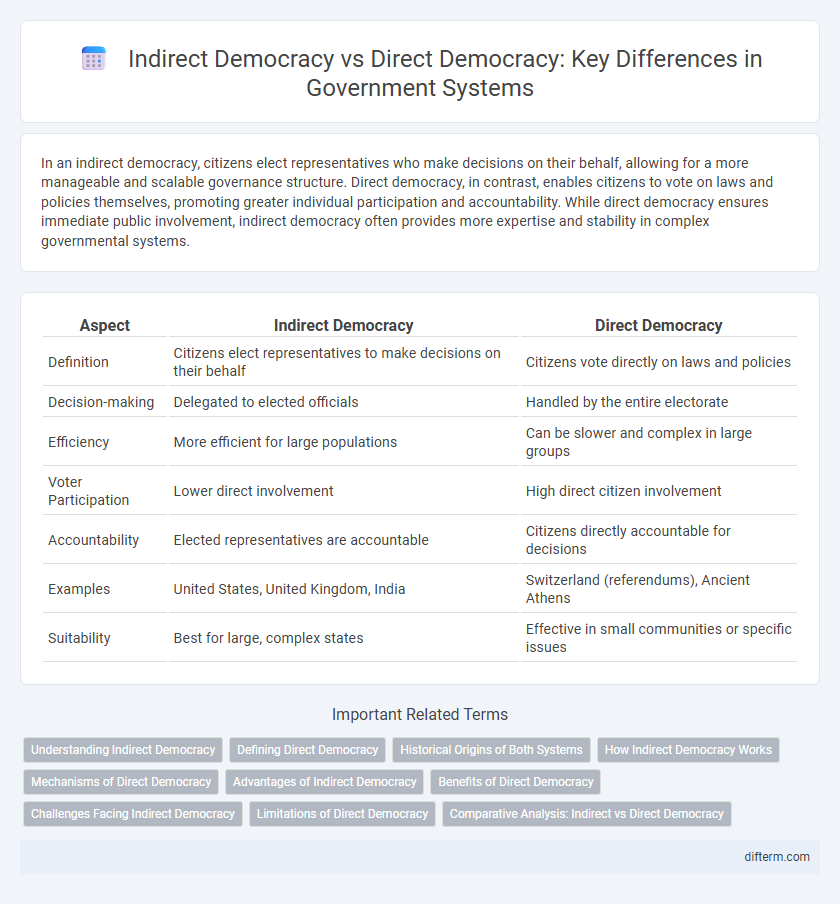In an indirect democracy, citizens elect representatives who make decisions on their behalf, allowing for a more manageable and scalable governance structure. Direct democracy, in contrast, enables citizens to vote on laws and policies themselves, promoting greater individual participation and accountability. While direct democracy ensures immediate public involvement, indirect democracy often provides more expertise and stability in complex governmental systems.
Table of Comparison
| Aspect | Indirect Democracy | Direct Democracy |
|---|---|---|
| Definition | Citizens elect representatives to make decisions on their behalf | Citizens vote directly on laws and policies |
| Decision-making | Delegated to elected officials | Handled by the entire electorate |
| Efficiency | More efficient for large populations | Can be slower and complex in large groups |
| Voter Participation | Lower direct involvement | High direct citizen involvement |
| Accountability | Elected representatives are accountable | Citizens directly accountable for decisions |
| Examples | United States, United Kingdom, India | Switzerland (referendums), Ancient Athens |
| Suitability | Best for large, complex states | Effective in small communities or specific issues |
Understanding Indirect Democracy
Indirect democracy, also known as representative democracy, involves citizens electing officials to make decisions on their behalf, ensuring a practical approach to governance in large populations. This system balances efficiency and accountability by allowing elected representatives to deliberate complex issues, which would be challenging in a direct democracy where citizens vote on every law. Indirect democracy supports diverse interests and fosters political stability, commonly seen in modern democratic governments worldwide.
Defining Direct Democracy
Direct democracy allows citizens to participate actively in decision-making by voting on laws and policies themselves, rather than through elected representatives. This form of governance emphasizes referendums, initiatives, and recalls as mechanisms for public influence. It contrasts with indirect democracy, where elected officials deliberate and decide on behalf of the populace.
Historical Origins of Both Systems
Indirect democracy, also known as representative democracy, traces its roots to ancient Rome, where citizens elected representatives to govern on their behalf, establishing a foundation for modern parliamentary systems. Direct democracy originated in ancient Athens, where eligible citizens participated directly in decision-making assemblies, influencing contemporary practices in referendums and initiatives. Both systems emerged as responses to the need for citizen participation in governance, reflecting distinct approaches shaped by historical contexts and political philosophies.
How Indirect Democracy Works
Indirect democracy functions through elected representatives who make decisions on behalf of the citizens, providing a structured system for managing large populations and complex governance. Voters select officials responsible for crafting laws, policies, and government actions, allowing for deliberation and expertise in decision-making. This method balances citizen participation with efficient administration, contrasting with direct democracy where individuals vote on every issue personally.
Mechanisms of Direct Democracy
Mechanisms of direct democracy include referendums, initiatives, and recalls, enabling citizens to vote directly on laws and policies. These processes bypass elected representatives, fostering greater public participation and accountability in governance. Direct democracy mechanisms often complement representative systems by providing a check on legislative decisions.
Advantages of Indirect Democracy
Indirect democracy allows for efficient decision-making by delegating authority to elected representatives who possess expertise and can thoroughly analyze complex issues. It enhances political stability by balancing diverse interests and reducing the risk of impulsive decisions driven by popular sentiment. This system promotes accountability through regular elections, enabling citizens to influence government policies without requiring constant direct involvement.
Benefits of Direct Democracy
Direct democracy empowers citizens to participate directly in decision-making processes, enhancing governmental transparency and accountability. It promotes greater public engagement by allowing individuals to vote on specific policies and laws, fostering a more informed and active electorate. This system reduces the risk of political corruption and elite manipulation by prioritizing popular will over representative intermediaries.
Challenges Facing Indirect Democracy
Indirect democracy faces significant challenges such as political disengagement, where citizens may feel disconnected from decision-making processes due to reliance on elected representatives. This system often grapples with issues of accountability, as representatives might prioritize party interests or lobbyists over public opinion. Furthermore, complexities in policymaking and slower legislative responses can hinder effective governance compared to direct democracy's immediate citizen involvement.
Limitations of Direct Democracy
Direct democracy faces limitations such as the impracticality of scaling in large populations, leading to slower decision-making processes and potential governance inefficiencies. Voter fatigue and lack of informed participation further hinder effective policy outcomes, as citizens may not possess the expertise required for complex issues. Reliance on frequent referenda can increase susceptibility to populism and manipulation by interest groups, undermining informed consensus.
Comparative Analysis: Indirect vs Direct Democracy
Indirect democracy empowers elected representatives to make policy decisions, facilitating governance in large, diverse populations by enabling efficient decision-making and accountability. Direct democracy allows citizens to participate directly in policy formation through referendums and initiatives, promoting greater public engagement and transparency but often facing challenges in scalability and informed decision-making. Comparative analysis reveals that indirect democracy balances practical governance with representative oversight, while direct democracy emphasizes citizen empowerment and responsiveness at the potential cost of administrative complexity.
indirect democracy vs direct democracy Infographic

 difterm.com
difterm.com